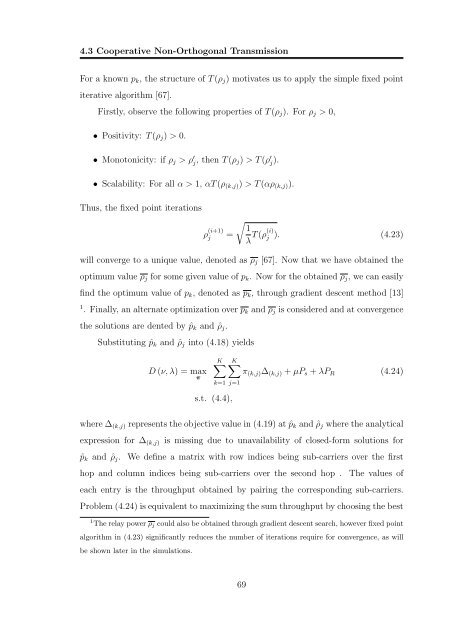Resource Allocation in OFDM Based Wireless Relay Networks ...
Resource Allocation in OFDM Based Wireless Relay Networks ...
Resource Allocation in OFDM Based Wireless Relay Networks ...
You also want an ePaper? Increase the reach of your titles
YUMPU automatically turns print PDFs into web optimized ePapers that Google loves.
4.3 Cooperative Non-Orthogonal Transmission<br />
For a known p k , the structure of T (ρ j ) motivates us to apply the simple fixed po<strong>in</strong>t<br />
iterative algorithm [67].<br />
Firstly, observe the follow<strong>in</strong>g properties of T (ρ j ). For ρ j > 0,<br />
• Positivity: T (ρ j ) > 0.<br />
• Monotonicity: if ρ j > ρ ′ j, then T (ρ j ) > T (ρ ′ j).<br />
• Scalability: For all α > 1, αT (ρ (k,j) ) > T (αρ (k,j) ).<br />
Thus, the fixed po<strong>in</strong>t iterations<br />
√<br />
ρ (i+1) 1<br />
j =<br />
λ T (ρ(i) j ). (4.23)<br />
will converge to a unique value, denoted as ρ j [67]. Now that we have obta<strong>in</strong>ed the<br />
optimum value ρ j for some given value of p k . Now for the obta<strong>in</strong>ed ρ j , we can easily<br />
f<strong>in</strong>d the optimum value of p k , denoted as p k , through gradient descent method [13]<br />
1 . F<strong>in</strong>ally, an alternate optimization over p k and ρ j is considered and at convergence<br />
the solutions are dented by ˆp k and ˆρ j .<br />
Substitut<strong>in</strong>g ˆp k and ˆρ j <strong>in</strong>to (4.18) yields<br />
D (ν, λ) = max<br />
π<br />
K∑ K∑<br />
π (k,j) ∆ (k,j) + µP s + λP R (4.24)<br />
k=1 j=1<br />
s.t. (4.4),<br />
where ∆ (k,j) represents the objective value <strong>in</strong> (4.19) at ˆp k and ˆρ j where the analytical<br />
expression for ∆ (k,j) is miss<strong>in</strong>g due to unavailability of closed-form solutions for<br />
ˆp k and ˆρ j . We def<strong>in</strong>e a matrix with row <strong>in</strong>dices be<strong>in</strong>g sub-carriers over the first<br />
hop and column <strong>in</strong>dices be<strong>in</strong>g sub-carriers over the second hop . The values of<br />
each entry is the throughput obta<strong>in</strong>ed by pair<strong>in</strong>g the correspond<strong>in</strong>g sub-carriers.<br />
Problem (4.24) is equivalent to maximiz<strong>in</strong>g the sum throughput by choos<strong>in</strong>g the best<br />
1 The relay power ρ j could also be obta<strong>in</strong>ed through gradient descent search, however fixed po<strong>in</strong>t<br />
algorithm <strong>in</strong> (4.23) significantly reduces the number of iterations require for convergence, as will<br />
be shown later <strong>in</strong> the simulations.<br />
69

















